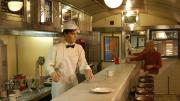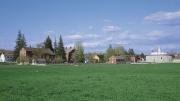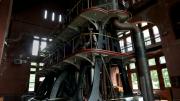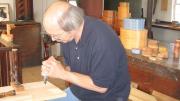Even with New England’s rich history, it may be surprising to learn that there are hundreds of small museums scattered across the region. “One story of our museums is a sort of a ‘tale of two cities,’” says Dan Yaeger, M.T.S. ’83, executive director of the New England Museum Association. “There are folks who are doing well, many of whom have expanded and built up a national profile, and there are many others with significant collections who are looking for their next meal.” The small Dedham Historical Society in Massachusetts, for example, is home to the Metcalf Chair, carved in 1652—the oldest dated Colonial American-made chair. Among the nearly 10,000 communications-related items at The New Hampshire Telephone Museum (in Warner) is an 1898 oak pay-phone unit that takes silver dollars. The Abbe Museum in Bar Harbor, Maine, depicts the life of the indigenous Wabanaki Nations through artifacts such as sewing needles made of bone. And the New Bedford Whaling Museum in Massachusetts boasts the only permanent exhibit space exploring Portuguese contributions to regional maritime culture. Here are six other small museums that highlight the breadth and depth of New England’s holdings.
Culinary Arts Museum
(at Johnson and Wales University)
Providence, R.I. | 401-598-2805
www.culinary.org
“Anyone who eats can find something they can resonate with here at the museum,” says Richard J.S. Gutman, the director and curator of this 25,000-square-foot treasure trove of anything related to cooking, eating, and hospitality. The 250,000-piece collection includes cookbooks, menus, antique stoves (look for the sculptural 1924 Hotpoint Automatic Range), counter appliances, advertisements, photographs, waitressing uniforms, and tin molds. “The purpose of the museum is to interpret food culture for the community here at the university,” Gutman explains. “We have thousands of young people going into the food industry and we are here to show them where things have come from, what’s going on now, and inspire them to change the world on a plate.”
His own research specialty is American diners. One of several permanent displays, Diners: Still Cookin’ in the 21st Century, features thick blue-plate dishware, archival photos of short-order chefs, an interactive kitchen for kids, and the original neon sign from a beloved 1930s icon: Moody’s Diner on Route 1 in Maine. Also open for faux business is the Ever Ready Diner, a restored 1926 Worcester Lunch Car last used in Providence, before being donated to the museum. “The diner was born in Rhode Island,” Gutman says, “and is an institution that has been constantly rediscovered by new generations tired of fast food, which is all the same, and those looking for a little personality.”
Visitors can also check out exquisite boxes made from chocolate with decorations looking like spun lace (made by Johnson and Wales students) and a series on wedding cakes. Food on the Move features TWA’s china from the “Ambassador’s Service” (first-class) dining set along with an original 1965 blue-green stewardess uniform and matching beret, chimes that called travelers to dinner on rail trips, and a TraCo aluminum tray used by carhops at drive-ins, which “revolutionized the eating habits of countless Americans, moving food service from the table to the car.” Gutman is planning to expand the Dinner at the White House exhibit with new donations from the Kennedy-era chef. For now, one can see Patricia Nixon showing off a gingerbread house, along with a menu from Abraham Lincoln’s second inaugural ball (among the delicacies was terrapin stew). “In the rush to partake of all the wonderful confections, meat dishes, and calf’s foot jelly, creams, and aspics, a lot of it ended up on the floor,” reports Gutman. “People treated it like a frat party. President and Mrs. Lincoln did come in but they didn’t stay long. The other revelers partied on until 4 a.m.”
Waterworks Museum
Boston (Chestnut Hill) | 617-277-0065
www.waterworksmuseum.org
As Boston’s population soared in the latter part of the 1800s it became clear that more and higher-quality water would be essential to keep the public healthy and hydrated. Seven major reservoirs were constructed, along with aqueducts that would fill the new Chestnut Hill Reservoir, which doubled as a popular city park. With that expansion came a neo-Romanesque pumping station, in 1887, that soon housed state-of-the-art, steam-powered engines.
The station, designed by H.H. Richardson protégé Arthur Vinal, and its massive marvels of mechanical engineering were finally opened to visitors last year after standing neglected for decades. “Waterworks,” explains executive director Beryl Rosenthal, “represent a high point in history where you had the confluence of architecture, science, and industry, along with a growing awareness of health issues and germ theory.” The pumping station was the first in the country to have an affiliated lab, founded by biologist George Whipple, that tested for contaminants.
The sandstone and granite station is worth visiting for its craftsmanship alone. Unusual masonry details abound and inside, a cathedral-like ceiling in the Great Engines Hall is composed of patterned pine bead board, along with three elegant brick arches and ornate interior moldings. The three engines, built in 1895, 1898, and 1916, respectively, are equally stunning, with their spiral staircases, giant valves, and artful design. “There is a sense of awe and mystery when you walk in and see the scale of these machines,” says Eric Peterson, A.L.M. ’11, director of operations. The museum explains the cultural and practical history of water use as well as the machines’ precise mechanics. Animated, three-dimensional renderings pull apart the inner workings to reveal how these engines, at their peak, pumped 100 million gallons of water a day to the city’s highest elevations.
The last of the three, the Worthington-Snow horizontal cross-compound engine, ran until the station was shut down in the mid 1970s, when the pressure aqueduct system was expanded and refined. A hard-won, grassroots effort saved the property from “re-adaption” by a developer (who did build adjacent condominiums), “because this was the nexus of the entire water supply for the Greater Boston area,” says Rosenthal. “It all flowed through here.”
New Britain Museum of American Art
New Britain, Conn. | 860-229-0257
www.nbmaa.org
Located 12 miles from Hartford, this vibrant museum features both a heralded permanent collection (e.g., the five-panel 1932 mural, The Arts of Life in America, by Thomas Hart Benton, and multiple works by the Connecticut-raised Sol LeWitt) and an exciting rotation of works by contemporary artists. It is also a major community resource for lectures, classes, concerts—and popular, art-themed parties. “The bread and butter of our mission is to have programs for a variety of ages at different levels of art appreciation,” says director Douglas Hyland. “We have 42 percent visitor participation in programs, which means they are not just walking around looking at art, they are taking classes and coming to films and other events.”
Hyland is adept at mixing and matching a dynamic display of old and new, traditional and provocative. Colonial portraiture, works from the Hudson River and Ashcan schools, as well as those of abstract artists like Milton Avery, are thoughtfully organized and rotated from the museum’s more than 11,000-piece collection, in which Winslow Homer, Mary Cassatt, Thomas Eakins, and Childe Hassam are represented.
The lush landscapes of New England artist Nelson H. White capture the day’s changing light along regional shorelines and marshlands (through October 14), and in the front courtyard (through November) stands a thoroughly contemporary, interactive piece called Particular Heights 2.0. Visitors can use a swing set that counts the accumulated swings while taking webcam stills of the users; the images are then fed into a gallery inside the museum. Artists Paul Theriault and Siebren Versteeg are exploring the process and meaning of constructed, recycling imagery and human action in the digital age.
Also on display are pieces from the museum’s unique collection of 1,782 American illustrations, largely gathered by its first director, Sanford B.D. Low, who, Hyland says, presciently saw their worth. Low’s friend Norman Rockwell personally donated the drawing Weighing In in 1969: the first of his illustrations to be housed in any museum. Complementing those, through December 9, is Pixelated: The Art of Digital Illustrations, which showcases some of the brightest current artists in the genre.
Since its founding in 1903, the museum has survived dramatic changes in its home base. Once known as the “hardware city” for its powerful concentration of manufacturers, New Britain now boasts chiefly Stanley Black & Decker (formerly Stanley Works), which is and has been a major corporate underwriter for the museum since it opened. “The industrialists who helped found the museum [its parent institute was chartered in 1853] saw an influx of immigrants coming into the city to work in the factories,” Hyland explains. The museum and its adjacent Walnut Hill Park, designed by Frederick Law Olmsted, were created, he adds, with “the idea that people here would have recreation and sports and also an art museum that would feed their minds and souls, and give people who had just come here from foreign countries an idea of the American experience.” Here, that mission is still being accomplished.
Lake Champlain Maritime Museum
(April through October)
Vergennes, Vt. | 802-475-2022
https://www.lcmm.org
From 1996 to 2006, the dive team of the Lake Champlain Maritime Museum painstakingly searched the watery depths of this 120-mile-long boundary between Vermont and New York State. They found more than 300 shipwrecks, ranging from eighteenth-century gunboats to pieces of steamboats and canal schooners, as well as other “cultural remains” like railroad trestles, two airplanes, and even a horse-drawn sleigh. Artifacts from the wrecks, along with other pieces of nautical history, are gathered at this sprawling shoreline museum to tell the fascinating story of who lived, fought, and did business in the region. “Throughout history, the lake has played a large role in opening up a corridor for trade and travel between the Great Lakes and the central United States and from New York City into Canada,” notes Eloise Beil, the museum’s director of collections and exhibits. Nine of the shipwrecks are designated underwater historic preserves. The museum hosts above-water boat tours in which visitors see what’s below through robots armed with cameras.
The museum also explains the lake’s role in several wars. Benedict Arnold fought British vessels using 15 gunboats on the lake, one of which, Philadelphia, was salvaged in 1935 and is on display at the Smithsonian’s National Museum of American History. The Maritime Museum has produced a full-sized, working replica, Philadelphia II, that can be boarded daily and serves as the centerpiece for annual reenactments of eighteenth- and nineteenth-century military and naval activities. Next summer a flotilla of replica sailing and rowing boats crewed by reenactors will dramatize the defense of Lake Champlain during the War of 1812.
A nautical archaeology research and conservation lab is open to the public, as are various exhibits on vintage outboard motors, a beautiful collection of wooden boats, a display about early relations between Europeans and indigenous peoples, and a comprehensive exploration of the canal-boat era (c. 1820-1940) that features the museum’s working replica, Lois McClure (which tours regional ports). Artifacts include possessions of a family that escaped an 1876 schooner wrecked during a storm: a china doll, a toy ship model, tools, dishes, a shoe, and a piece of a stove. Such are the depths of history revealed.
The Willard House and Clock Museum
North Grafton, Mass | 508-839-3500
www.willardhouse.org
This house museum is dedicated to the Willard family of clockmakers, whose pioneering horological technology and insistence on elite craftsmanship helped set them apart from other regional clockmakers for about a century, starting in 1766. Some 80 clocks are on display, primarily made by four brothers who were born and raised in the home: Benjamin, Ephraim, Aaron, and Simon. (Simon, considered the best clockmaker, cared for Harvard’s timepieces for 50 years; his 1829 banjo clock, named for its shape, still keeps time for the Faculty of Arts and Sciences.) “Simon and his brothers helped forward the technology of clocks, which made timekeeping much more accessible,” says museum director Patrick Keenan. “Before they invented the eight-day, weight-driven banjo clock in 1802, all clocks were 30-hour clocks, which meant they had to be wound every day instead of once a week.” Timekeeping was a key aspect of keeping schedules and working outside the home in an increasingly industrialized society.
The clocks, all weight-driven by pendulums, came in three types: tall case clocks, or Roxbury-style; highly decorative shelf clocks; and the gallery/banjo clock. Also famous is the Willard cylindrical “Lighthouse Clock,” among the first to have a built-in alarm. One example, adorned with a cameo of the Marquis de Lafayette, sits in the White House library. Willard clocks were much sought after. In 1801, Simon made a large gallery clock for the U.S. Senate that was destroyed when the British burned Washington. Through that job he became friends with Thomas Jefferson, who later hired him to make a clock for the University of Virginia (which also later burned). His clocks also hung in the U.S. Capitol and in what was then (1837) the U.S. Supreme Court chamber.
The Willards created the clocks’ inner workings while the dials, cabinets (often mahogany), and decorative details, such as gilding or miniature landscapes, were farmed out to other artisans. “All of the pieces are a marriage of technology and art,” Keenan says. It took three to six weeks to make a mechanism from scratch and as many as nine months to finish one clock. “All the ones here are still running after 200 years,” he adds. “You just don’t find that kind of care in making things anymore.”
Hancock Shaker Village
(April through October)
Pittsfield, Mass. | 413-443-0188
www.hancockshakervillage.org
Although the Shakers occupied a relatively small slice of American history, their religious utopian vision and artistic legacy have endured—even thrived. The Hancock Shaker Village, built and occupied by Shakers from 1780s until 1960, offers one of the best opportunities to delve into their way of life. Eighteen buildings, including the beautiful 1862 Round Stone Barn, along with artifacts—from their signature slender-legged furniture and tools to handmade clothing and household objects, such as the elegant oval wooden boxes—are all on display. (The museum has more than 22,000 objects, among the largest Shaker collections in the world. Also worth touring are the Shaker museums in Canterbury and Enfield, New Hampshire.)
At Hancock, visitors can stroll the village, meeting interpreters—some in costume—engaged in Shaker activities such as blacksmithing, quilting, and woodworking. “We also have a working, community-supported farm, so visitors can talk with people in the gardens and who work with the animals,” says marketing director Laura Wolf.
The Shakers’ commitment to gender equality is explored and depicted in their dormitory sleeping arrangements: each hall housed men and women in rooms on respective sides, rather than on separate floors, for example. Visitors can also sit in a meetinghouse where Shakers worshipped and learn about their beliefs at different stages. “One height of their spiritualism was a period in the mid 1800s they call the ‘Era of Manifestation,’” Wolf explains, “when they received spiritual gifts during worship or meditation, such as new artwork, songs, poems, and messages about how the community should interact with one another.” To learn more and celebrate the Shaker tradition at harvest time, attend the village’s annual country fair on September 29 and 30.













































